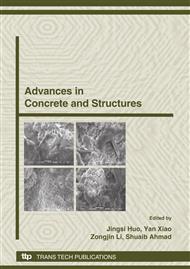p.371
p.379
p.385
p.391
p.395
p.403
p.409
p.415
p.421
Four Point Bending Experimental Investigation on Reinforced Ultra High Toughness Cementitious Composite Beams
Abstract:
Ultra high toughness cementitious composite (abbreviated as UHTCC) shows significant pseudo strain hardening behavior and offers prominent tension strain ability of more than 3% when subjected to uniaxial tension load. The failure pattern of the UHTCC components exhibits multiple fine cracks with crack width lower than 100μm even corresponding to the ultimate tensile strain state. Four-point bending investigations of reinforced ultra high toughness cementitious composite (RUHTCC) members without web reinforcement have been carried out due to the excellent crack dispersion and strain energy absorption abilities of UHTCC material, aiming at design issues of strictly anti-cracking structures or aseismic design in key parts of structures such as beam column joint when using UHTCC. The moment-curvature curves have been measured and compared with the theoretical analysis proposed before. There is a reasonable agreement between them, especially that both moment and curvature present little difference before yielding. According to experimental results of RUHTCC beams with three different reinforcement ratios, UHTCC can delay yielding of reinforcements and improve load bearing capacity and ductility of structures or components compared with ordinary reinforced concrete beams, then steel products can be saved. The possibility of corrosion should be evidently reduced in respect that RUHTCC can effectively control crack. Accordingly, durability of structures improves by using UHTCC members.
Info:
Periodical:
Pages:
395-401
Citation:
Online since:
October 2008
Authors:
Price:
Сopyright:
© 2009 Trans Tech Publications Ltd. All Rights Reserved
Share:
Citation:


